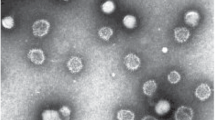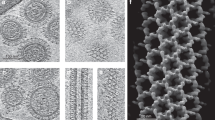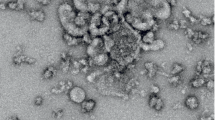Summary
Three strains of foot-and-mouth disease virus were shown to contain significant amounts of naturally occurring 75 S, empty particles as well as the infectious, 140 S full particles. One of these strains — A Pando (1970) — was studied in detail.
The empty particles from this virus strain were shown to have an observed sedimentation coefficient of 67S in 0.04m phosphate buffer; they were labile in SDS, non-infectious and probably RNA-free and, on heating, they broke down to 12 S subunits as did the 140 S particles. The empty particles differed from the full particles in their polypeptide composition since they contained VP0, but there was no evidence for a diminished content of VP4.
The 75 S particles were shown to be present in significant amounts and to be stable to AEI inactivation. At 4° C they were stable for at least two years. In guinea pigs they were as immunogenic as the 140 S particles. The antisera raised against the 75 S particles had the same serological specificity in neutralization tests as sera prepared against the 140 S particle. It was concluded that the 75 S particles from the A Pando (1970) strain of FMD virus may provide as important a contribution as 140 S particles to the immunogenicity of inactivated vaccines prepared from this virus strain.
Similar content being viewed by others
References
Anderson, E. C., Capstick, P. B., Mowat, G. N., Leech, F. B.:In vitro method for safety testing of foot-and-mouth disease vaccines. J. Hyg.68, 159–172 (1970).
Barteling, S. J., Meloen, R. H.: A simple method for the quantitation of 140 S particles of foot-and-mouth disease. Arch. ges Virusforsch.45, 362–364 (1974).
Black, D. N.: Proteins produced in BHK cells by infection with foot-and-mouth disease virus. J. gen. Virol.26, 109–119 (1975).
Brown, F.: Replication of picornaviruses. In:Williams, J. D., Geddes, A. M. (eds.), Chemotherapy. New York: Plenum Publishing Corp. 1976.
Brown, F., Cartwright, B.: Purification of radioactive foot-and-mouth disease virus. Nature (London)119, 1168–1170 (1963).
Brown, F., Hyslop, St. G., Crick, J., Morrow, A. W.: The use of acetylethyleneimine in the production of inactivated foot-and-mouth disease vaccines. J. Hyg.61, 337–344 (1963).
Brown, F., Newman, J. F. E.:In vitro measurement of the potency of inactivated foot-and-mouth disease vaccines. J. Hyg.61, 345–351 (1963).
Capstick, P. B., Garland, A. J., Masters, R. C., Chapman, W. G.: Some functional and morphological alteration occurring during and after the adaptations of BHK 21 Clone 13 cells to suspension culture. Exp. Cell Res.44, 119–128 (1966).
Capstick, P. B., Garland, A. J., Chapman, W. G., Masters, R. C.: Factors affecting the production of foot-and-mouth disease virus in deep suspension culture of BHK 21 Clone 13 cells. J. Hyg.65, 273–280 (1967).
Cavanagh, D.: Ph. D. Thesis, University of Reading, 1976.
Cowan, K. M.: Antibody response to viral antigens. Adv. Immunol.17, 195–253 (1973).
Garland, A. J. M., Mowat, G. N., Fletton, B.: An evaluation of some methods of assay of foot-and-mouth disease antigen for vaccines. International Symposium on foot-and-mouth disease, Lyon 1976. Development in Biological Standardization.35, 323–332. Basel: S. Karger 1977.
Graves, J. H., Cowan, K. M., Trautman, R.: Immunochemical studies of foot-and-mouth disease. II. Characterisation of RNA-free virus like particles. Virology34, 269–274 (1968).
Henderson, W. M.: The quantitative study of foot-and-mouth disease. Agricultural Research Council Series, No. 8. London: Her Majesty's Stationery Office 1949.
Liebermann, Ht., Meissner, J., Schulze, P., Thalmann, G.: Einige physikalischchemische Eigenschaften der 73 S-Einheit des Maul- und Klauenseuche-Virus. Arch. exp. Vet.-Med. (Leipzig)30, 813–821 (1976).
Macpherson, I. A., Stoker, M. G. P.: Polyoma transformation of hamster cell clones—an investigation of genetic factors affecting cell competence. Virology16, 147–151 (1962).
Maizel, J. B., Jr.: Polyacrylamide gel electrophoresis of viral proteins. In:Maramorosch, K., Koprowski, H. (eds.), Methods in Virology5, 179–246. London: Academic Press 1971.
Pereira, H. G.: Subtyping of foot-and-mouth disease virus. International Symposium on foot-and-mouth disease, Lyon 1976. Development in Biological Standardization35, 167–174. Basel: S. Karger 1977.
Planterose, D. N., Ryan, J. K. O.: A 65 S particle containing viral protein in cells infected with foot-and-mouth disease virus. Virology26, 372–374 (1965).
Rowlands, D. J., Cartwright, B., Brown, F.: Evidence for an internal antigen in foot-and-mouth disease virus. J. gen. Virol.4, 479–487 (1969).
Rowlands, D. J., Sangar, D. V., Brown, F.: A comparative chemical and serological study of the full and empty particles of foot-and-mouth disease virus. J. gen. Virol.26, 227–238 (1975).
Rweyemamu, M. M., Booth, J. C., Head, M., Pay, T. W. F.: Microneutralization tests for serological typing and subtyping of foot-and-mouth disease virus strains. J. Hyg.81, 107–123 (1978).
Sangar, D. V., Rowlands, D. J., Smale, C. J., Brown, F.: Reaction of glutaraldehyde with foot-and-mouth disease virus. J. gen. Virol.21, 399–406 (1973).
Strobbe, R., Lacroix, C., Charlier, G., Debecq, J.: Routine titration of foot-and-mouth disease virus suspensions by analytical ultracentrifugation. Arch. exp. Vet.-Med. (Leipzig)30, 325–331 (1976).
Telling, R. C.: Industrial production of FMD vaccine using BHK21 suspension cells. Some comparative results relatingin vitro assays and cattle potency. Report of Meeting of Research Group Standing Technical Committee of the European Commission for the Control of Foot-and-Mouth Disease. Brescia, Italy, Appendix XVII, 95–100, F. A. O. Rome.
Wild, T. F., Brown, F.: A study of the physical properties of the immunizing antigen of foot-and-mouth disease virus and the effect of various inactivating agents on its structure. Arch. ges. Virusforsch.24, 86–103 (1968).
Author information
Authors and Affiliations
Additional information
With 5 Figures
Rights and permissions
About this article
Cite this article
Rweyemamu, M.M., Terry, G. & Pay, T.W.F. Stability and immunogenicity of empty particles of foot-and-mouth disease virus. Archives of Virology 59, 69–79 (1979). https://doi.org/10.1007/BF01317896
Received:
Accepted:
Issue Date:
DOI: https://doi.org/10.1007/BF01317896




